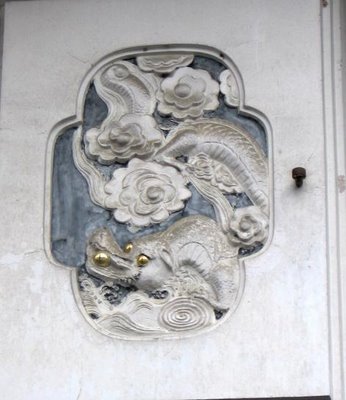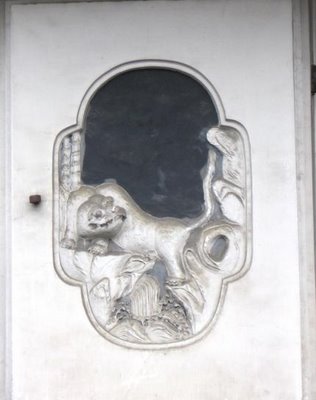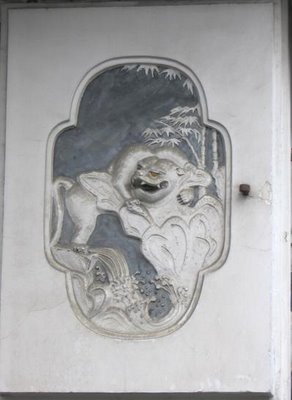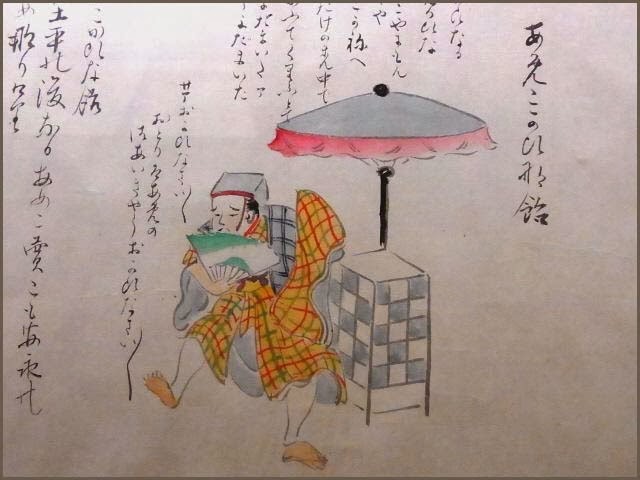:::::::::::::::::::::::::::::::::::::::::::::::::::::::::::::::::::::::::::::::::::::::::::::::::::::::::::::::::::::::::::::::::::::::::::::::::::::::::::::::::::::::::::::::::::::
chaya, -jaya 茶屋 tea shop, tea stall
saten, chaten, chamise 茶店
sabo 茶房 modern tea houses also serve coffee (kissaten 喫茶店)
This is part of the main entry about
. Doing Business in Edo - 江戸の商売 .
Many tea stalls had a little side business :
. fuuzoku, fûzoku 風俗 Fuzoku, entertainment and sex business .
fuuzoku 風俗 refers to the manners and customs, and in a wider sense in Edo to the flourishing sex business.
Under the unauspicious name of "tea stall", a lot of extra entertaiment was available in Edo.
Along the public roads to the countryside, there were many chaya for travellers to rest.

along the 木曾街道 上尾宿 Kiso Kaido road, Angeo-Juku
『東海道五拾三次之内 袋井』- Tokaido, Fukuroi
『東海道五拾三次之内 大津宿』- Tokaido, Otsu
『木曾街道 板橋之驛』 - Kiso Kaido, Itabashi
『木曽海道六拾九次之内 高﨑』- Kiso Kaido, Takasaki
LOOK at these prints:
- source : ja.wikipedia.org
. The 53 stations of the Tokaido Road 東海道五十三次 .
..............................................................................................................................................
. Chayamachi, Chayachoo 茶屋町 district in Asakusa 浅草 in Edo .
Residence of
Chaya Shirōjirō 茶屋四郎次郎 Chaya Shirojiro
. Chayazaka, Chaya-zaka 茶屋坂 Chayazaka "Tea Stall Slope" .
Meguro 目黒区三田二丁目 Mita second district, 中目黒二丁目 Naka-Meguro second district
- Jiji ga Chaya 爺々が茶屋 Grandfather's Tea House
. Ohanajaya お花茶屋 Ohanajaya district . - Katsushika
- "Tea stall of the girl O-Hana"
:::::::::::::::::::::::::::::::::::::::::::::::::::::::::::::::::::::::::::::::::::::::::::::::::::::::::::::::::::::::::::::::::::::::::::::::::::::::::::::::::::::::::::::::::::::
. aimai 曖昧女(おんな) onna, woman, prostitute
in a shop called Aimaiya 曖昧屋, providing front and back service, so to speak . . .
..............................................................................................................................................
amigasa chaya 編笠茶屋 renting a large braided straw hat
to hide the face for a Yoshiwara pleasure quarter visit.

source : ukiyo-e.org/image
Mizuno Toshikata, 1891
..............................................................................................................................................
dango chaya だんご茶屋 Tea stall selling dumplings Mt. Utsu and Poetry
..............................................................................................................................................
deaijaya, deai chaya 出会茶屋. 出会い茶屋"tea stall to meet someone"

source : chuukyuu.info/who/edo
Ikenohata no deaijaya 池ノ端の出会茶屋

CLICK for further reference !
男木女水で来る出会茶屋
otoko ki onna mizu de kuru deai-jaya
the men as trees
the woman as water come
to this tea-shop
the tea-for-two
where men come as trees,
women as water
- source : Robin D. Gill -
The Woman Without a Hole - ; Other Risky Themes from Old Japanese Poems
with more poems and info to explore on this link!
- quote -
Eight Fashionable Views of Edo:
Vespers Bedmate at Ueno / Ueno no Bansho
Suzuki Harunobu
a couple entwined while enjoying the view of water lilies on Shinobazu pond from the second story window of a teahouse at Ueno

The poem is a parody associated with Mii no bansho (Vespers [or Evening] Bell at Mii), which is one of the Omi Hakkei (Eight Views of Omi), a popular visual parody based on the classic Chinese theme Eight Views of the Xiao and the Xiang.
A poem found on a Harunobu chuban from circa 1768 (Waterhouse, no. 316) shifts the 'Evening Bell' from Miidera to Ueno:
kono yama no koro machietaru hana sakari yoso ni wa tsuke yo
On this holy hill
we waited for the season
of the flower blossom:
sound your doleful note elsewhere
vespers bell of Ueno!
The poem on this shunga print also places the bell in Ueno but in a further erotic parody of the theme. The phrase 'iriai no kana' is replaced with 'ireai no ane'; and 'sho' for concubine replaces 'sho' for bell. The poem explains the young man is on his yadosagari, the annual break given to the samurai for home leave which was granted for a few days in the 3rd month and was typically either spent at home or at an inn. The Shinobazu Pond at Ueno was well-known for its lotus and for the deai-chaya (meeting tea-houses) which had rooms overlooking the pond.
kono hodo mo sazo tsutaetaru yadosagari yoban tsuzukete ireai no ane
This is the extent
to which he as passed it on
during his home leave:
four times in succession he
joined with the elder sister!
- source : scholten-japanese-art.com -
..............................................................................................................................................

hikite chaya, hikitejaya, hikidejaya 引手茶屋
- quote -
Nihon Embankment, Yoshiwara - Yoshiwara Nihonzutsumi
The mile-long Nihon Embankment, constructed in 1620, was the final stage in the journey of visitors to the Yoshiwara licensed pleasure quarter (yûkaku), which was situated among rice paddies to the north of the city. The Yoshiwara was moved here after a fire in 1657 at its original location near the centre of Edo. The roofs of the Yoshiwara can be seen at the end of the embankment beyond the 'Looking-back Willow' (Mikaeri Yanagi) which was situated at the top of the slope leading to the main gate; here parting guests would pause to take a lingering 'look back' at dawn, before making the trip back along the embankment.

Utagawa Hiroshige
Arriving by boat, or by foot through the theatre district, the visitor would hire a palanquin carried by bearers for the journey along the embankment, or would go on foot, concealing his identity beneath a dark hood, with cheek cover (hôkammuri-zukin).
The route was lined with over 100 teahouses (hikite-chaya) where clients could make advance arrangements with the particular brothel advertised on the red lantern hanging outside.
- source : fitzmuseum.cam.ac.uk -
..............................................................................................................................................
irojaya 色茶屋 "tea shop to meet colors" (prostitutes)
iro is an euphemism for erotic entertainment.
..............................................................................................................................................
. kagemajaya, kagema chaya 陰間茶屋 "tea house with boys in waiting" .
the young boys also had a side business:
jigami uri 地紙売り kagema boys selling paper for fans - and talking about kabuki
..............................................................................................................................................

kakejaya, kake chaya 掛け茶屋 / 掛茶屋 refreshment shops
simple roadside stalls with small seats or benches. They had simple yoshizu 葦簾 reed screens to provide some shade.

source : blog.goo.ne.jp/tetthan
A modern replica near Fukagawa
掛茶屋のほこりに座るあつさ哉
kakejaya no hokori ni suwaru atsusa kana
it is so hot
I sit down in the dust
of a wayside tea stall . . .
掛茶屋に風追分のすゝみ哉
掛茶屋の灰はつめたしきりきりす
掛茶屋は芦生に似たる昼寝哉
掛茶屋や頭にさはる藤の花 藤
. Masaoka Shiki 正岡子規 .
..............................................................................................................................................
machiaijaya, machiai chaya 待合茶屋 " tea shop for waiting and meeting"
with rooms where visitors and geisha could amuse themselves for a while, before going on to the theater or some other entertainment.
..............................................................................................................................................
mizujaya, mizu chaya 水茶屋 "public tea house" for refreshments and meeting ladies

江戸水茶屋風俗考 - 佐藤要人

source : blog.goo.ne.jp/aboo-kai
mizuchaya no kanban musume 水茶屋の看板娘 Kamban "advertising servant girl"
signboard girl, they worked outside the shop, trying to attract customers.
水茶屋ぬりいの渋茶や赤だすき
mizu chaya nurui no shibucha ya akadasuki
lukewarm bitter tea
at the wayside tea shop -
red sash to hold the sleeves
Kanban musume 看板娘 Kambanmusume O-Sen
. Kasamori O-Sen (1751 - 1827) 笠森お仙 .
at the Kasamori Shrine in Edo

kanban musume at the Meguro Fudo Temple
from a series of 100 beauties of Edo by
江戸名所百人美女 (国芳) Utagawa Kuniyoshi.
. . . CLICK here for more Photos !
. Edo no bijin 江戸の美人 the beauties of Edo .
.......................................................................
- quote -
Mizu-shōbai (水商売), or the water trade,
is the traditional euphemism for the night-time entertainment business in Japan, provided by hostess or snack bars, bars, and cabarets. Kabuki-chō in Shinjuku, Tokyo is Japan's most famous area where one can patronize the water trade, as well as its more carnal counterpart fūzoku (風俗)—the sex industry composed of soaplands, pink salons, health, and image clubs.
While the actual origin of the term mizu-shōbai is debatable, it is likely the term came into use during the Tokugawa shogunate (1603–1868). The Tokugawa period saw the development of large bathhouses and an expansive network of roadside inns offering hot baths and sexual release, as well as the expansion of geisha districts and courtesan quarters in cities and towns throughout the country. Bearing relation to ukiyo (浮世 and 憂世), or "the floating world", mizu-shōbai is a metaphor for floating, drinking and impermanence..
According to one theory proposed by the Nihon Gogen Daijiten, the term comes from the Japanese expression
"Gain or loss is a matter of chance" (勝負は水物だ shōbu wa mizumono da), where literal meaning of the phrase "matter of chance", mizumono (水物), is "matter of water".
In the entertainment business, income depends on a large number of fickle factors like popularity among customers, the weather, the state of the economy, and success and failure change as rapidly as a flow of water.
The Nihon Zokugo Daijiten, on the other hand, notes that the term may derive from the expression doromizu-kagyō (泥水稼業), lit. "muddy water earning business", for earning a living in the red-light districts, or from the Edo-era expression mizuchaya (水茶屋) for a public teahouse.
- - - More in the WIKIPEDIA !
..............................................................................................................................................
ryoorijaya, ryoori chaya 料理茶屋 tea stalls serving food
. . . CLICK here for Photos !
. Tôto ryûkô san-jû-rokkaiseki 東都流行三十六会席 Toto Ryuko Sanjurokkaiseki
Thirty-six Fashionable Restaurants of the Eastern Capital .
Aoyanagi 青柳 Restaurant in Ryogoku
..............................................................................................................................................
. Sangenjaya 三軒茶屋 Sangen-jaya, "three tea stalls" .
District in 世田谷区 Setagaya ward
..............................................................................................................................................
shibaijaya, shibai chaya 芝居茶屋 tea shop near a theater

© More in the WIKIPEDIA !
at Saruwaka choo 猿若町の芝居茶屋
the three famous Kabuki theaters of Edo
. Edo Sanza 江戸三座 .
堺町・葺屋町 Sakai Machi
木挽町 Kobiki choo
猿若町 Saruwaka choo. later renamed Nakamura-za
..............................................................................................................................................
sumoojaya, sumoo chaya 相撲茶屋 tea shop near a Sumo arena
煮凝の鍋かくしあり角力茶屋
長谷川かな女
. sumoo 相撲 Sumo wrestling .
..............................................................................................................................................
tatebajaya, tateba chaya 立場茶屋 serving food by the roadside, eating whilst standing
. Takanawa district 高輪, Takanawadai 高輪台 .
famous for its tea stalls
..............................................................................................................................................

source : fxst2003.exblog.jp/
tooge no chaya 峠の茶屋, toogejaya 峠茶屋 tea house at a pass
At the bottom of the pass for travellers to rest before the ascent.
Or at the top of a smaller pass to enjoy the view.
夏山や水に乏しき峠茶屋
natsu yama ya mizu ni toboshiki toogejaya
summer mountain -
at the tea stall near the pass
water is in shortage
. WKD - Masaoka Shiki 正岡子規 .
- - - - -
一本のラムネの甘露峠茶屋
ippon no ramune no kanro toogejaya
the sweet taste
of one bottle of lemonade -
this tea stall at the pass
Nakayama Junko 中山純子
. WKD : ramune ラムネ lemonade .
..............................................................................................................................................
tsukimijaya, tsukimi chaya 月見茶屋 tea house for moon viewing
. yaozen 八百善 Yaozen restaurant .
a ryoori chaya 料理茶屋 "tea stall serving food" in Asakusa
:::::::::::::::::::::::::::::::::::::::::::::::::::::::::::::::::::::::::::::::::::::::::::::::::::::::::::::::::::::::::::::::::::::::::::::::::::::::::::::::::::::::::::::::::::::
Some chaya are even KIGO for haiku :
shimizujaya, shimizu chaya 清水茶屋 stall selling tea made with fresh water
takimijaya, takimi chaya 滝見茶屋 teahouse near a waterfall

source : kanko.city.izu.shizuoka.jp
:::::::::::::::::::::::::::::::::::::::::::::::::::::::::::::::::::::::::::::::::::::::::::::::::::::::::::::::::::::::::::::::::::::::::::::::::::::::::::::::::::::::::::::::::::::
. Yosa Buson 与謝蕪村 in Edo .
しら梅や北野の茶店にすまひ取
shiraume ya kitano no chaya ni sumai tori
white plum blossoms -
at the tea-house in Kitano
there is a Sumo wrestler
. Shrine Kitano Tenmangu 北野天満宮 - Kyoto . .
藤の茶屋あやしき夫婦休けり
fuji no chaya ayashiki meoto yasumikeri
tea house under wisterias -
a suspicious couple
stopped to rest
名月や夜は人住まぬ峰の茶屋
meigetsu ya yo wa hito sumanu mine no chaya
full autumn moon -
nobody stays at night
at the tea stall of the peak
花火せよ淀の御茶屋の夕月夜
hanabi seyo yodono o-chaya no yuuzuki yo
"Start the fireworks"
A moonlit evening
At a tea house in Yodo.
Tr. Nelson/Saito
かしこくも茶店出しけり夏木立
峯の茶屋に壯士餉す若葉哉
汗入れて妻わすれめや藤の茶屋
:::::::::::::::::::::::::::::::::::::::::::::::::::::::::::::::::::::::::::::::::::::::::::::::::::::::::::::::::::::::::::::::::::::::::::::::::::::::::::::::::::::::::::::::::::::
. Kobayashi Issa 小林一茶 in Edo .
茶屋村の一夜に出来しさくらかな
chaya mura no hito yo ni dekishi sakura kana
a tea stall village
built over night
for cherry blossom viewing . . .
Tr. Gabi Greve
The cut marker KANA is at the end of line 3.

source : www.qkamura.or.jp/chausu
芋茶屋もうれしいものよ閑古鳥
imo chaya mo ureshii mono yo kankodori
even a cheap tea stall
can make me so happy -
mountain cuckoo
Tr. Gabi Greve
imo 芋 Japanese taro potato
- - - - - MORE haiku by Issa
あっさりと朝夕立のお茶屋哉
assari to asa yuudachi no ochaya kana
春風や八文芝居だんご茶や
harukaze ya hachi mon shibai dango chaya
一本の梅でもちたる出茶屋哉
ippon no ume de mochitaru de-chaya kana
爺茶屋や右に左に閑古鳥
jiji chaya ya migi ni hidari ni kankodori
陽炎やきのふは見へぬだんご茶屋
kagerô ya kinou wa mienu dango chaya
貝殻で家根ふく茶屋や梅の花
kaigara de yane fuku chaya ya ume no hana
都ぢや梅干茶屋の梅の花
miyakoji ya umeboshi chaya no ume no hana
芝でした腰掛茶屋や夏木立
shiba de shita koshikake chaya ya natsukodachi
浮草の花よ来い来い爺が茶屋
ukikusa no hana yo kii kii jiji ga chaya
山陰や涼みがてらのわらぢ茶屋
yama kage ya suzumi-gatera no waraji chaya
夕立のとんだ所の野茶屋哉
yuudachi no tonda tokoro no no chaya kana
存の外俗な茶屋有萩の花
zon no hoka zoku na chaya ari hagi no hana
- source and translations by David Lanoue -
:::::::::::::::::::::::::::::::::::::::::::::::::::::::::::::::::::::::::::::::::::::::::::::::::::::::::::::::::::::::::::::::::::::::::::::::::::::::::::::::::::::::::::::::::::::
. WKD - Masaoka Shiki 正岡子規 .
秋風の上野の出茶屋人もなし
紅葉あり夕日の酒屋月の茶屋
茶屋あらはに灯火立つや霧の中
茶屋ありや山辺の水の心太
茶屋を見て走りついたる心太
茶屋に到り瓜喰はんと思ひつゝ
茶屋に菊あり遠足會の人休む
茶屋の茶に清水の味はなかりけり
茶屋もなく酒屋も見えず花一木
茶屋を出る箱提灯や朧人
茶屋アリテ夫婦餅売ル春の山
茶屋女芦生の昼寝起しけり
茶屋敷の五尺の庭の落葉哉
茶屋淋し絲瓜の蔓の這ひかゝる
茶屋静かに鹿徘徊す若楓
野の茶屋に懐爐の灰をかへにけり
野の茶屋に柿買ふて遠く歩きけり
野の茶屋に蜜柑竝べし小春哉
松風に甘酒さます出茶屋かな
松風に甘酒わかす出茶屋かな
松風の甘酒を吹く出茶屋哉
松風を得意で売るや納涼茶屋
陽炎の次第にふとる野茶屋哉
落葉はく上野の茶屋の女哉
落葉掃く腰掛茶屋の女哉
葉桜に夜は茶屋無し向島
葉桜に夜は茶屋無し隅田川
蛾の飛んで陰気な茶屋や木下闇
鹿にやる菓子の殘りや紅葉茶屋
鷹据て人憩ひ居る野茶屋哉
追分や鷄飼ふ茶屋の柿石榴
蝶々や人なき茶屋の十団子
萱草や茶屋のつき山苔もなし
遠クカラ見エシ此松氷茶屋
酒を賣る紅葉の茶屋に妖女あり
くたびれや心太くふて茶屋に寝る
ちりかゝる桜の茶屋のともし哉
つゝじ折るつゝじが茶屋の女哉
どぶ六に野茶屋は暮て朧月
のどかさや出茶屋の煙土手の人
ほそほそと烟立つ茶屋の落葉かな
一銭の氷少き野茶屋かな 氷売る
三味線を掛けたる春の野茶屋哉
何見るそ桜の茶屋の遠見鏡
花ちるや人なき夜の葭簀茶屋
八月や人無き茶屋の青楓
冬されや稲荷の茶屋の油揚
冬枯や蛸ぶら下る煮賣茶屋
冬の日やよらで過ぎ行く餅の茶屋
南岸の茶屋北岸の寺やむら紅葉
夕涼み山に茶屋あり松もあり
夕露に灰のつめたき野茶屋哉
大声で話す凉みや滝の茶屋
婆々が茶屋夜は虫鳴く處哉
山上の茶屋に鮓ありそれを喰ひぬ
帷子に風吹き起る滝の茶屋
日影薄く梅の野茶屋の寒哉
日暮るゝや桜の茶屋の繋ぎ馬
早起山を越え炎天を茶屋に休む人
星月夜星を見に行く岡の茶屋
春の夜や茶屋の二階の影法師
春の川出茶屋の前を流れけり
春の水出茶屋の前を流れけり
昼顔の上に火を焚く野茶屋哉
朝顔や野茶屋の垣根まばらなり
木にかける氷の旗や荷ひ茶屋
枯薄人呼ぶ茶屋の婆もなし
枯野原團子の茶屋もなかりけり
栗の花茶屋一軒を隠しけり
栗飯や目黒の茶屋の發句會
梅のさく門は茶屋なりよきやすみ
氷売る柳の陰の出茶屋かな
汗を吹く茶屋の松風蝉時雨
涼しさや滝を茶に煮る滝の茶屋
涼しさや駕を出づれば滝の茶屋
田螺売る野茶屋に藤の花早き
砂村や茶屋のかたへの枯尾花
滝の茶屋にそゞろ昼寝の足寒し taki no chaya
end of the Masaoka Shiki list
......................................................................
asama no chaya 浅間の茶屋 at Mount Asama
ayu chaya 鮎茶屋 serving ayu trout fish
?bunnosuke chaya 文の助茶屋
eki chaya 駅茶屋 at a train station
fuji chaya 藤茶屋 surrounded by wisteria
gion chaya 祇園茶屋 in Gion, Kyoto
hagi no chaya 萩の茶屋 surrounded by bush clover
hama chaya 浜茶屋 at the beach
hanami chaya 花見茶屋 for viewing cherry blossoms
henro chaya 遍路茶屋 for henro pilgrims in Shikoku
higuchi chaya 火口茶屋 at a volcano
kai no chaya 峡の茶屋 at an inlay
kanakana no chaya 蜩の茶屋 to listen to evening cicadas
kifune chaya 貴船茶屋 at Kifune (Kibune) Kyoto
mimasaka no chaya 美作の茶屋 in Mimasaka (Okayama prefecture)
momiji chaya 紅葉茶屋 for viewing red autumn leaves
monzen chaya 門前茶屋 in front of a temple access road
nara no chaya 奈良の茶屋 in Nara
no chaya 野茶屋 in the wild fields
seta no chaya 瀬田の茶屋 at Seta
Shiki no chaya 子規の茶屋 in momory of Masaoka Shiki
shiro chaya 城茶屋 near a castle
tachiyu chaya 立場茶屋 at a hot spring
kakane chaya 高嶺茶屋 at a high mountain peak
tera chaya 寺茶屋 at a temple
tsuboyaki no chaya 壺焼の茶屋 using or selling Tsuboyaki pottery
umemi chaya 梅見茶屋 for viewing plum blossoms
wakaba chaya 若葉茶屋 in the young green leaves
yama chaya 山茶屋 at a mountain
yoshisu 葭簀茶屋 with reed grass blinds
Huge collection of CHAYA haiku :
- source : HAIKUreikuDB
hasumi chaya 蓮見茶屋 for viewing lotos flowers
:::::::::::::::::::::::::::::::::::::::::::::::::::::::::::::::::::::::::::::::::::::::::::::::::::::::::::::::::::::::::::::::::::::::::::::::::::::::::::::::::::::::::::::::::::::

『岐阻街道 奈良井宿 名産店之圖 Kiso Road, Narai Station, Nr. 34
歌川広重 Utagawa Hiroshige
. Nakasendoo 中山道 Nakasendo Road .
the Kisokaidō, Kiso Kaido (木曾街道) Kisoji 木曽路
..............................................................................................................................................
niken chaya 二軒茶屋 two tea stalls
:::::::::::::::::::::::::::::::::::::::::::::::::::::::::::::::::::::::::::::::::::::::::::::::::::::::::::::::::::::::::::::::::::::::::::::::::::::::::::::::::::::::::::::::::::::

- - - To join me on facebook, click the image !
:::::::::::::::::::::::::::::::::::::::::::::::::::::::::::::::::::::::::::::::::::::::::::::::::::::::::::::::::::::::::::::::::::::::::::::::::::::::::::::::::::::::::::::::::::::
. - Doing Business in Edo - 商売 - Introduction .
[ . BACK to DARUMA MUSEUM TOP . ]
[ . BACK to WORLDKIGO . TOP . ]
- #chaya #teastall -
:::::::::::::::::::::::::::::::::::::::::::::::::::::::::::::::::::::::::::::::::::::::::::::::::::::::::::::::::::::::::::::::::::::::::::::::::::::::::::::::::::::::::::::::::::::













































